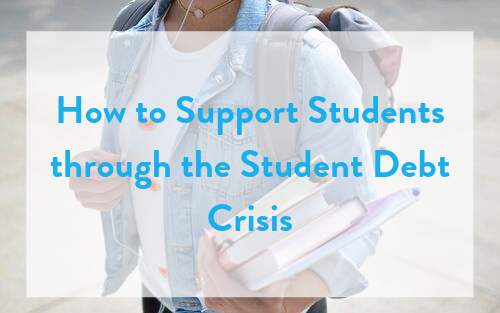Student debt has reached an all-time high, with 45 million borrowers owing a total of over $1.56 trillion in debt. According to Student Loan Hero, that’s $521 billion more than the total U.S. credit card debt. Many agree that this startling statistic most definitely qualifies student debt as a crisis in the U.S.
This crisis is taking a toll on students and college graduates in a number of different ways. For many college graduates, loans have gotten in the way of purchasing a home, having children, buying a car, and even the ability to pay for groceries. Student loans are also affecting entire families — a recent study found that only 13% of families use 529 college savings plans, and instead 42% of families take out loans to pay for college.
Studies have also shown that women and minorities are more likely to be more heavily impacted by the student loan crisis. The gender pay gap plays a role in preventing women from paying off their loans as quickly as their male colleagues. When it comes to borrowing federal loans, the National Center for Education Statistics found that 86.8% of black students borrow federal loans compared to 59.9% of white students.
Many colleges and universities recognize that in order to create a sustainable future for higher education, institutions need to play their part in supporting students through this crisis, and helping to ensure it does not continue to worsen. Below, we outline four ways that higher education institutions can support today’s student population through the student debt crisis.
1. Create a “payback playbook” for students.
The student loan payback process can be very confusing for a new graduate; that may just be simply learning what it actually means to have debt. There is a lot of jargon when it comes to student loans — like subsidized, unsubsidized, deferment, principal, forbearance — and it can be hard for a new graduate to figure out what all of this means on their own.
Just like colleges and universities prepare students to go out and practice a craft in the real world, they should also prepare them to be financially responsible. Many times, the only notification a student receives is an email about their grace period from the lender, and then a bill six months after graduation, letting them know their grace period has ended and it’s time to pay.
By offering either an in-person or online course on student loans, this can enable students with the chance to learn the ins and outs of student loans, ask questions, and create a custom plan that they can put into action when they graduate. Perhaps colleges could implement this useful information to students online using an easy-to-use software such as, Launch, that could be added to students portals. This will clarify all of the jargon related to loans, allow them to create a budget before they accept a job (so they know what they need to earn), and ensure that they reduce principal, not just the interest.
2. Educate students about loan forgiveness options.
While not every student will qualify for one of these programs, there are a number of different loan forgiveness programs that could help students decrease their debt. Student Loan Hero offers a list of all forgiveness programs, including ones for people who work in health care, education, public service, military and more.
Some examples of forgiveness programs include Public Service Loan Forgiveness, where if an individual were to work in a public service job after college, they may qualify for this program. Jobs that qualify include but aren’t limited to: Teach for America, Court translator, Public non-profits, military or public health, law enforcement, public teaching, and public service law.
States have also begun to offer special assistance, like Maine’s Alfond Student Debt reduction program that provides student loan repayment assistance for people who live and work in Maine in a STEM-designated occupation.
It’s important to note that applying and getting accepted to a loan forgiveness program can be a lengthy process. This means students should plan accordingly, and the process of how to apply should be included in their “payback playbook” course.
3. Create a support group students can access after they graduate.
After a student graduates, they may feel that they no longer have the support of their college to walk them through questions about their student loans that they are now being asked to start paying off. A great way to not only help graduates, but also keep a strong connection with alumni, is to offer an online loan support group. This could be in the form of a Facebook or LinkedIn group, or it could live in a section of a custom alumni portal using Launch software.
Support groups can offer additional resources and suggestions for student loans, offer free consultations, and enable individuals to lean on other graduates for advice, that have successfully paid off their student loans. The more alumni that feel supported, the deeper connection they’ll have with their college, resulting in more financial stability.
4. Teach students how to avoid scams.
The massive amount of student debt is not only making headlines in politics, but catching the eye of scammers. According to CNBC, scammers have cost student loan borrowers over $95 million. Often, the scam takes the form of a robocall, where a graduate receives a call about how they can greatly reduce student loan payments or even completely get rid of them for a small fee.
Robocalls are on the rise, so it’s important for students to know how to look out for them. Students should be wary of inquiries that:
-Offer fast loan forgiveness. Real loan forgiveness programs can take up to 10 years.
-Ask for a fee. There are a variety of resources available for free.
-Ask for a FSA ID. Never share a FSA ID.
-Promise to completely get rid of debt.
-Claim to have a relationship with the Department of Education.
-Promise to remove a student’s debt because their school is being sued.
Again, this is great information to include in loan preparation courses, or even as a notification in a student portal as students near graduation.






